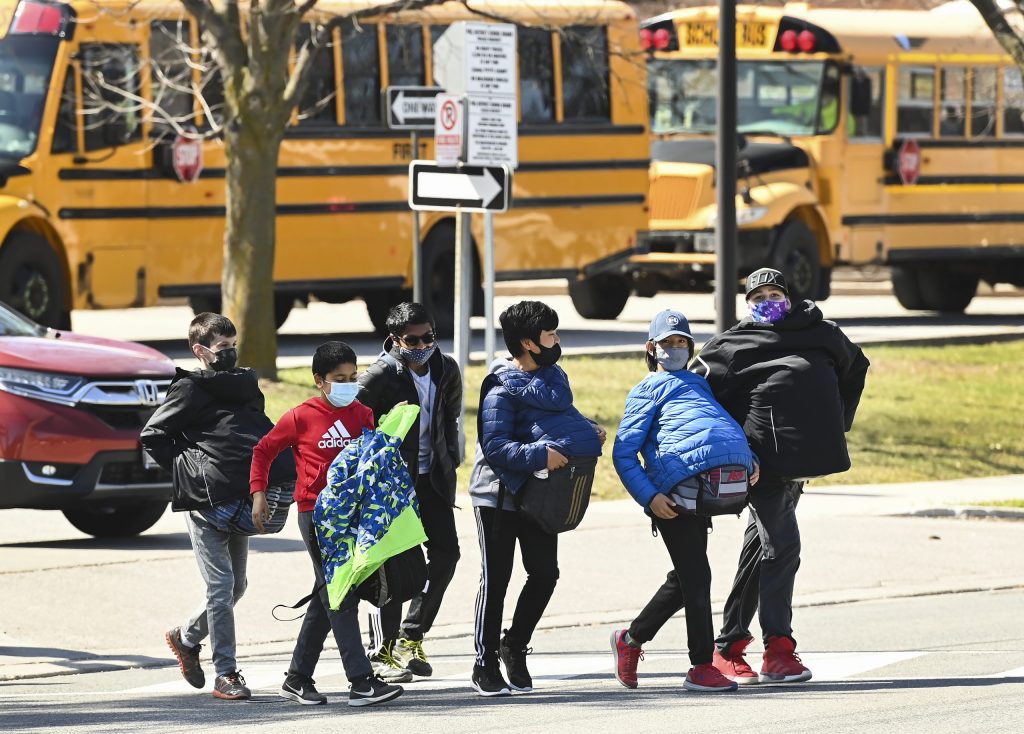Ontario science advisory group recommends extra curriculars resume, schools stay open

Posted July 19, 2021 4:12 pm.
Last Updated July 19, 2021 4:34 pm.
TORONTO – Ontario’s science advisory table is recommending a much different school year, with the return of extracurriculars, loosening masking, distancing and cohorting rules when risk is low, and closing schools only in catastrophic scenarios.
“The physical, emotional, and developmental health of children and youth has been deeply impacted by the COVID-19 pandemic and restrictions placed on schools,” the experts write in a brief published Monday.
“School closures, or transition to an online learning model, should not be used as a public health measure for pandemic control.”
There is “increasing evidence” that closing schools and cancelling extracurriculars have had negative impacts on kids’ physical and mental health, they write.
Ontario has had the longest interruption to in-person classes in Canada.
But given high vaccination rates in the province, the science table expects low levels of transmission of the virus and hospitalizations in the fall.
“In-person learning is essential for the learning and overall well-being of children and youth. Therefore, barring catastrophic circumstances, schools should remain open for in-person learning,” the advisory table continues.
The brief lays out low-, moderate- and high-risk scenarios. When the risk is considered low – hospitalizations are “limited and sporadic” – then masking, distancing and cohorting rules could be relaxed, they say.
Recommendations for Masking Indoors in Schools:

Masks could be optional if infection rates and severe disease remain low, but masking guidance in schools should follow community guidance for indoor settings, the experts write. Outdoor masking isn’t recommended except when community transmission is high and distancing isn’t possible.
On the subject of masks, the science table says the measure “is one of the temporary measures that can be more easily adjusted throughout the school year.”
“When adequate vaccination rates are obtained such that infection rates and severe disease remain low and stable, masking guidance in schools should follow community guidance for indoor settings.”
Neither physical distancing nor cohorting is recommended in the low-risk scenario.
In moderate- and high-risk scenarios, distancing should be considered depending on age.
“In kindergarten and elementary years, cohorting and masking should be emphasized over distancing, as outlined in the Cohorting and Masking sections, respectively,” the science table says.
“In middle school and high school, masking should be prioritized over cohorting to optimize the learning model (e.g., allow students to participate in the regular class schedule, avoid condensed learning) and support independent development.”
Full release:
[pdf-embedder url=”https://www.680news.com/wp-content/blogs.dir/sites/2/2021/07/19/Science-Brief_School-Operation-for-the-2021-2022-Academic-Year-in-the-Context-of-the-COVID-19-Pandemic_20210719_published.pdf” title=”Science Brief_School Operation for the 2021-2022 Academic Year in the Context of the COVID-19 Pandemic_20210719_published”]
But when the risk increases, cohorting and masking could return for younger children – who find it more difficult to distance – while masking and distancing are preferred strategies for older students, since cohorting makes schooling, socializing and extra-curricular activities more difficult.
“Supported by $1.6 billion in investments to protect schools, expand mental health, and support learning recovery, our back to school plan will work to ensure a more normal in-class learning experience, including reinstating clubs, sports, and extra-curriculars,” Education Minister Stephen Lecce’s spokesperson, Caitlin Clark, said Monday.
“We will continue to work with Ontario’s Chief Medical Officer of Health to get all students back to in-person learning this September, supported by rising vaccine rates and $1.6 billion in resources to continue to keep schools safe. As part of our plan, and as recommended by Ontario’s Science Table, all students aged 12 and over and education workers are prioritized for double vaccination prior to September and significant investments have been made to improve air ventilation in 100 per cent of schools.”
Proper handwashing, having staff and students stay home when sick, upgrading indoor air quality systems, and enhanced cleaning measures should be considered permanent measures, they say.
But even when the risk is high – when hospitalizations from COVID-19 are high and continuing to rise – schools should stay open, the experts urge, with prioritized testing and tracing and vaccination.
“School closures and transitions to remote learning should only be considered under a catastrophic scenario, based on the recommendation of the chief medical officer of health, when there is a clear signal of harm (morbidity and/or mortality) to children or the community at large that is directly attributable to children attending school for in-person learning despite the use of all available mitigation strategies,” the science advisers say.
The loss of extra-curricular activities has had a “substantial impact” on kids’ physical and mental health, the experts say, and those should resume even in high-risk scenarios.
Activities such as choir and sports could take place outside, and rapid antigen screen testing could be used to mitigate risk, they write in the brief.
On Monday, Ontario colleges and universities were told they should prepare for all in-person classes and activities to resume this fall without capacity limits or physical distancing, though many institutions will still use a mix of in-person and online learning.
The Ministry of Colleges and Universities has told the institutions to have plans for how learning will continue in the event of COVID-19 outbreaks.
“While we must remain vigilant and responsive to the trajectory of COVID-19, I am optimistic that the (post-secondary education) sector will resume many of the cherished in-person experiences that have been on pause for so long,” deputy minister Shelley Tapp wrote in a recent memo to the institutions.
Tapp said it’s “anticipated” that all in-person instruction and on-campus activities will be allowed again this fall, after more than a year since they were paused due to the pandemic.
Universities and colleges will still have to follow all public health and workplace safety rules, including requiring masks indoors, Tapp said.








